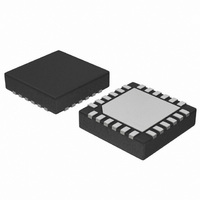NB7VQ1006MMNG ON Semiconductor, NB7VQ1006MMNG Datasheet - Page 6

NB7VQ1006MMNG
Manufacturer Part Number
NB7VQ1006MMNG
Description
IC EQUALIZER RECEIVER 24-QFN
Manufacturer
ON Semiconductor
Datasheet
1.NB7VQ1006MMNTXG.pdf
(10 pages)
Specifications of NB7VQ1006MMNG
Logic Type
Equalizer Receiver
Supply Voltage
1.71 V ~ 2.625 V
Number Of Bits
1
Operating Temperature
-40°C ~ 85°C
Mounting Type
Surface Mount
Package / Case
24-TFQFN Exposed Pad
Lead Free Status / RoHS Status
Lead free / RoHS Compliant
Available stocks
Company
Part Number
Manufacturer
Quantity
Price
Company:
Part Number:
NB7VQ1006MMNG
Manufacturer:
ON Semiconductor
Quantity:
1
Part Number:
NB7VQ1006MMNG
Manufacturer:
ON/安森美
Quantity:
20 000
NOTE: Device will meet the specifications after thermal equilibrium has been established when mounted in a test socket or printed circuit
8. Measured using a 400 mV source, 50% duty cycle 1GHz clock source. All outputs must be loaded with external 50 W to V
9. Output voltage swing is a single−ended measurement operating in differential mode.
10. V
11. Duty cycle skew is measured between differential outputs using the deviations of the sum of T
12. Within device skew compares coincident edges.
13. Device to device skew is measured between outputs under identical transition
14. Additive CLOCK jitter with 50% duty cycle clock signal.
15. Additive Peak−to−Peak jitter with input NRZ data at PRBS23.
16. Input voltage swing is a single−ended measurement operating in differential mode, with minimum propagation change of 25 ps.
Table 6. AC CHARACTERISTICS
Symbol
f
f
V
V
t
t
t
t
t
t
V
t
DATA
MAX
PLH
PHL
PLH
DC
SKEW
JITTER
r
, t
OUTPP
CMR
INPP
rates 40 ps (20% − 80%).
input signal.
f
CMR
,
Frequency (f
TC
500
450
400
350
300
250
board with maintained transverse airflow greater than 500 lfpm. Electrical parameters are guaranteed only over the declared
operating temperature range. Functional operation of the device exceeding these conditions is not implied. Device specification limit
values are applied individually under normal operating conditions and not valid simultaneously.
Figure 3. Output Voltage Amplitude (V
min varies 1:1 with GND, V
0
Maximum Operating Input Data Rate
Maximum Input Clock Frequency
Output Voltage Amplitude EQEN = 0 or 1
(See Figures 4, Note 9)
Input Common Mode Range (Differential Configuration, Note 10) (Figure 8)
Propagation Delay to Output Differential, IN/IN to Qn/Qn
Propagation Delay Temperature Coefficient −40°C to +85°C
Output Clock Duty Cycle
Duty Cycle Skew (Note 11)
Within Device Skew (Note 12)
Device to Device Skew (Note 13)
Random Clock Jitter RJ(RMS), 1000 cycles (Note 14) EQEN = 1f
Deterministic Jitter (DJ) (Note 15) EQEN = 1, FR4 = 12”, v10 Gbps
Input Voltage Swing (Differential Configuration) (Note 16) (Figure 6)
Output Rise/Fall Times Qn/Qn, (20% − 80%)
Q Output Amplitude (mV) V
1
f
IN
in
Q Output Amplitude (mV) V
, CLOCK INPUT FREQUENCY (GHz)
) at Ambient Temperature (Typ), (EQEN = 0)
2
3
CMR
4
V
max varies 1:1 with V
CC
CC
= V
Characteristic
= 1.8 V
5
CCO
CC
= 1.71 V to 2.625 V; GND = 0 V T
= 2.5 V
OUTPP
6
f
f
f
in
in
in
http://onsemi.com
f
5 GHz v f
in
v 5.0 GHz V
v 7.5 GHz V
v 6.5 GHz V
) vs. Input
v 5 GHz V
7
CC
. The V
6
8
in
V
V
V
V
v 7.5 GHz
CC
CC
CMR
CC
CC
CC
CC
CC
CC
= 2.5 V
= 1.8 V
= 2.5V
= 1.8V
= 2.5V
= 2.5V
= 1.8V
= 1.8V
in
range is referenced to the most positive side of the differential
v 5.0 GHz
V
IN
IN
A
T
= −40°C to 85°C (Note 8)
50 W
50 W
Figure 4. Input Structure
pw
1050
Min
275
225
225
200
170
100
7.5
6.5
10
48
− and T
pw
V
0.15
Typ
440
360
360
315
225
CC
0.2
0.2
+ @ 5 GHz.
30
50
10
20
30
3
3
V
CC
1200
Max
315
0.7
1.2
52
25
40
40
20
65
1
− 50
CCO
. Input edge
Gbps
GHz
fs/°C
Unit
mV
mV
mV
ps
ps
ps
ps
%










